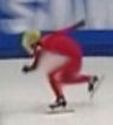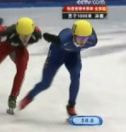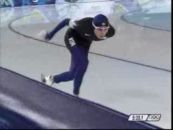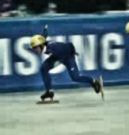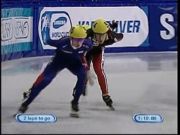Press In to PushBy Susan Ellis, April 2011
|
You've got to get up every morning with determination if you're going to go to bed with satisfaction. ~ G H Lorimer |
This article is really an elaboration of the article on Presscoopinchpushpinish – December 2009 but is such an important part of the initiation of the movement I thought it needed more detail.
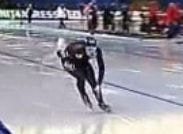 Click image to watch video
Click image to watch video
So many things have changed in skating over the last 10 years, from basic position, to how people skate tracks, rule changes, and even the way we push. One of the major changes I have made in teaching the straightaway push is to take away the lean of the entire body in to the push, and just push straight down in to the ice to start the push. This loads more pressure under the heel at the beginning of the push. Even though the pressure at high speed still finishes with the ball of the foot, more time is spent under the front part of the heel and middle of the blade before finishing with the ball. Starting the push straight down also allows you to change how fast you bring the pressure forward, or even to switch the pressure forward and back on your blade – undulating pressure. It also allows you to keep your weight over top of your pushing leg longer than just falling away from your push.
Downward pressure is exerted through the pushing hip by compressing at the hip joint. The action is almost like trying to crunch an orange between your upper thigh and your lower belly where your leg inserts into your torso. As you are pressing down through the hip your hips move under you and also start to press across as your leg moves away from you. Pressing down in this manner ensures that pressure is starting right from the large outer hip muscles and not just from the thigh muscles as in the leaned push.
Look at the sequence of motion in the clips below. Notice the compression at the hip joint. The chest and belly compress down towards the thigh while the butt cheeks remain pointed at the ice. Notice the ankle bending and the knee moving forward at the same time.
Downward pressure is exerted through the pushing hip by compressing at the hip joint. The action is almost like trying to crunch an orange between your upper thigh and your lower belly where your leg inserts into your torso. As you are pressing down through the hip your hips move under you and also start to press across as your leg moves away from you. Pressing down in this manner ensures that pressure is starting right from the large outer hip muscles and not just from the thigh muscles as in the leaned push.
Look at the sequence of motion in the clips below. Notice the compression at the hip joint. The chest and belly compress down towards the thigh while the butt cheeks remain pointed at the ice. Notice the ankle bending and the knee moving forward at the same time.
|
Be very careful that you don’t just press the chest down. This just causes the butt cheeks to rise up out of the push as in the photo to the left, and the weight to fall forward too fast. By the same token, don’t just press the hip down as this causes too much weight to fall backwards and the chest to rise as in the photo to the right. |
The goal in initiating the push is to put pressure in a straight line down through the pushing hip and keep pressing straight down as the leg moves away from the body. The hips should stay level and not tilt through the push. Watch the skater in blue in each of these clips as he presses down in to his push while the hips stay level and move across.
|
In the video to the right, HS Lee, 10000m Olympic gold medalist, looks like what some people would say is bobbing. However, watch very closely and you will see that he only rises at the very end of his push, when the push is complete, and then descends back down through his hip to put pressure in to his push again. This allows him to take some pressure off his pushing leg during the recovery phase and is a very different motion than bobbing up out of a push. |




